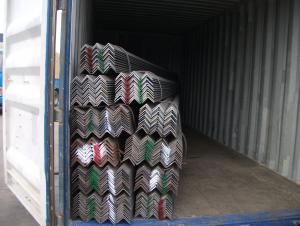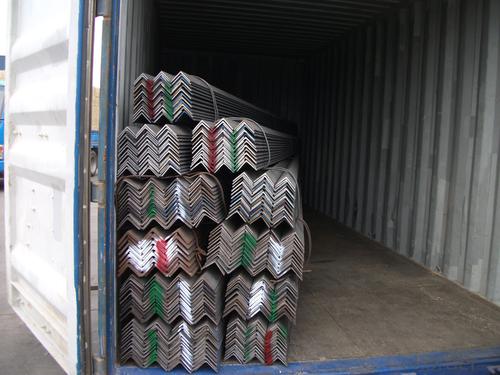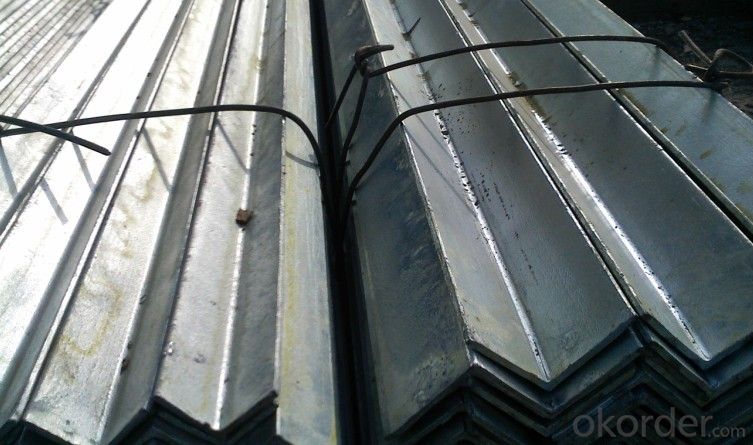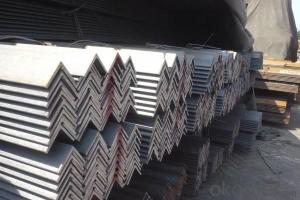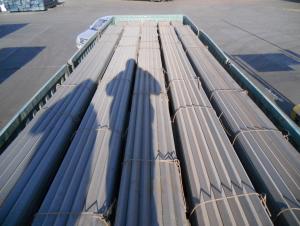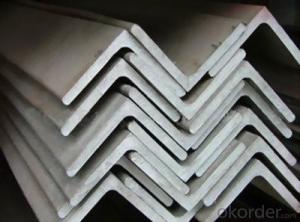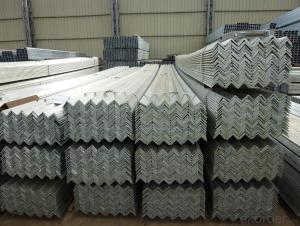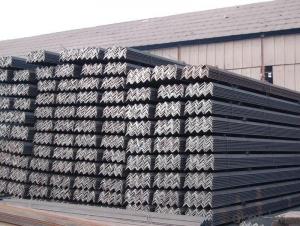JIS SS400 High Quality Angle Steel
- Loading Port:
- China Main Port
- Payment Terms:
- TT or LC
- Min Order Qty:
- -
- Supply Capability:
- -
OKorder Service Pledge
OKorder Financial Service
You Might Also Like
Product Description:
OKorder is offering JIS SS400 High Quality Angle Steel at great prices with worldwide shipping. Our supplier is a world-class manufacturer of steel, with our products utilized the world over. OKorder annually supplies products to European, North American and Asian markets. We provide quotations within 24 hours of receiving an inquiry and guarantee competitive prices.
Product Applications:
JIS SS400 High Quality Angle Steel are ideal for structural applications and are widely used in the construction of buildings and bridges, and the manufacturing, petrochemical, and transportation industries.
Product Advantages:
OKorder's JIS SS400 High Quality Angle Steel are durable, strong, and resist corrosion.
Main Product Features:
· Premium quality
· Prompt delivery & seaworthy packing (30 days after receiving deposit)
· Corrosion resistance
· Can be recycled and reused
· Mill test certification
· Professional Service
· Competitive pricing
Specifications of JIS SS400 Angle Steel
1.Standards:GB,ASTM,BS,AISI,DIN,JIS
2.Invoicing on theoretical weight or actual weight as customer request
3.Material: JIS G3192,SS400;SS540.
4. Payment terms:
1).100% irrevocable L/C at sight.
2).30% T/T prepaid and the balance against the copy of B/L.
3).30% T/T prepaid and the balance against L/C
5.Sizes:
EQUAL ANGLES SIZES |
| ||
a(mm) | a1(mm) | thickness(mm) | length |
25 | 25 | 2.5---3.0 | 6M/12M |
30 | 30 | 2.5---4.0 | 6M/12M |
38 | 38 | 2.5 | 6M/12M |
38 | 38 | 3.0---5.0 | 6M/12M |
40 | 40 | 3.0---6.0 | 6M/12M |
50 | 50 | 3 | 6M/12M |
50 | 50 | 3.7---6.0 | 6M/9M/12M |
60 | 60 | 5.0---6.0 | 6M/9M/12M |
63 | 63 | 6.0---8.0 | 6M/9M/12M |
65 | 65 | 5.0---8.0 | 6M/9M/12M |
70 | 70 | 6.0---7.0 | 6M/9M/12M |
75 | 75 | 5.0---10.0 | 6M/9M/12M |
80 | 80 | 6.0---10.0 | 6M/9M/12M |
90 | 90 | 6.0---10.0 | 6M/9M/12M |
100 | 100 | 6.0---12.0 | 6M/9M/12M |
120 | 120 | 8.0-12.0 | 6M/9M/12M |
125 | 125 | 8.0---12.0 | 6M/9M/12M |
130 | 130 | 9.0-12.0 | 6M/9M/12M |
140 | 140 | 10.0-16.0 | 6M/9M/12M |
150 | 150 | 10---15 | 6M/9M/12M |
160 | 160 | 10---16 | 6M/9M/12M |
180 | 180 | 12---18 | 6M/9M/12M |
200 | 200 | 14---20 | 6M/9M/12M |
5. Material Specifications:
Grade | Yield Strength,N/mm² | Extension Strength N/mm² | |||
Thickness of Steel,mm | |||||
≦16 | >16-≦40 | >40-≦100 | >100 | ||
SS330 | ≧205 | ≧195 | ≧175 | ≧165 | 330-430 |
SS400 | ≧245 | ≧235 | ≧215 | ≧205 | 400-510 |
SS490 | ≧285 | ≧275 | ≧255 | ≧245 | 490-610 |
SS540 | ≧400 | ≧390 | - | - | ≧540 |
Usage & Applications JIS SS400 Angle Steel
Trusses;
Transmission towers;
Telecommunication towers;
Bracing for general structures;
Stiffeners in structural use.
Packaging & Delivery of JIS SS400 Angle Steel
1. Transportation: the goods are delivered by truck from mill to loading port, the maximum quantity can be loaded is around 40MTs by each truck. If the order quantity cannot reach the full truck loaded, the transportation cost per ton will be little higher than full load.
2. With bundles and load in 20 feet/40 feet container, or by bulk cargo, also we could do as customer's request.
3. Marks:
Color mark: There will be color marking on both end of the bundle for the cargo delivered by bulk vessel. That makes it easily to distinguish at the destination port.
Tag mark: There will be tag mark tied up on the bundles. The information usually including supplier logo and name, product name, made in China, shipping marks and other information request by the customer.
If loading by container the marking is not needed, but we will prepare it as customer request.
Production flow of JIS SS400 Angle Steel
Material prepare (billet) —heat up—rough rolling—precision rolling—cooling—packing—storage and transportation
FAQ:
Q1: Why buy Materials & Equipment from OKorder.com?
A1: All products offered byOKorder.com are carefully selected from China's most reliable manufacturing enterprises. Through its ISO certifications, OKorder.com adheres to the highest standards and a commitment to supply chain safety and customer satisfaction.
Q2: How do we guarantee the quality of our products?
A2: We have established an advanced quality management system which conducts strict quality tests at every step, from raw materials to the final product. At the same time, we provide extensive follow-up service assurances as required.
Q3: How soon can we receive the product after purchase?
A3: Within three days of placing an order, we will begin production. The specific shipping date is dependent upon international and government factors, but is typically 7 to 10 workdays.
Images:

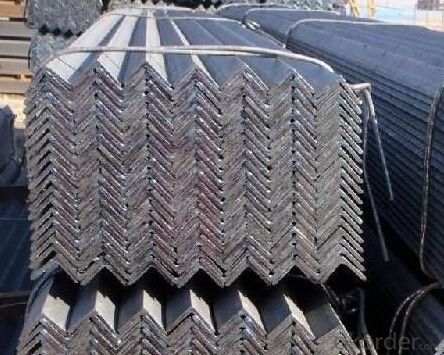
- Q: Are steel angles available in different grades?
- Yes, steel angles are available in different grades.
- Q: What are the different types of steel angles used in automotive manufacturing?
- In automotive manufacturing, there are several types of steel angles that are commonly used. These steel angles are crucial components in the construction and design of various automotive structures and parts. Some of the different types of steel angles used in automotive manufacturing include: 1. Equal Angle: This type of steel angle has equal length sides that form a 90-degree angle. Equal angles are typically used in automotive manufacturing for structural applications, such as chassis frames, brackets, and suspension components. 2. Unequal Angle: As the name suggests, unequal angles have unequal length sides that form a 90-degree angle. These angles are commonly used in automotive manufacturing to create components with specific dimensions and angles, such as door frames, body reinforcements, and support structures. 3. L Angle: L angles, also known as angle irons, have two equal length sides that form a 90-degree angle. They are widely used in automotive manufacturing for various purposes, including reinforcing panels, mounting brackets, and structural supports. 4. T Angle: T angles have one long side and one short side that form a 90-degree angle, resembling the letter "T." They are commonly utilized in automotive manufacturing for joining different components, such as body panels, fenders, and roof structures. 5. C Angle: C angles, also called channel angles, have a C-shaped cross-section. They are extensively used in automotive manufacturing for applications requiring structural strength and rigidity, such as frame rails, roll cages, and support beams. 6. Z Angle: Z angles have a Z-shaped cross-section, resembling the letter "Z." They are commonly employed in automotive manufacturing for joining and reinforcing various components, such as door frames, roof structures, and body reinforcements. These are just a few examples of the different types of steel angles used in automotive manufacturing. Each type serves a specific purpose and offers unique properties, such as strength, stability, and flexibility, to meet the requirements of different automotive applications.
- Q: What are the common connections or fasteners used with steel angles?
- Steel angles can be connected or fastened using a variety of methods and materials. Bolts, screws, welds, and rivets are commonly used in this regard. When attaching steel angles to other structural elements or connecting multiple angles together, bolts and screws are often the go-to option. Welding, on the other hand, involves heating and fusing the angles together, resulting in a strong and durable bond. Rivets, which involve inserting a metal pin through holes in the angles and securing them with hammering or mechanical pressing, provide an alternative method of connection. The choice of connection or fastener depends on factors such as the specific application, load requirements, and desired aesthetics.
- Q: Are steel angles susceptible to fatigue failure?
- Yes, steel angles can be susceptible to fatigue failure. Fatigue failure occurs when a material undergoes repeated loading and unloading cycles, leading to the initiation and propagation of cracks within the material. Steel angles, like any other structural components, can be subject to cyclic loading conditions, such as vibrations, oscillations, or repeated stress applications. Fatigue failure in steel angles is influenced by various factors, including the material's properties, the geometric shape of the angle, the magnitude and frequency of the applied loads, and the presence of any defects or stress concentrations. The presence of notches, welds, or sharp corners can act as stress raisers, leading to localized stress concentrations and potential crack initiation sites. To mitigate the risk of fatigue failure, engineers and designers consider several strategies. Firstly, understanding the anticipated loading conditions and designing the structure with appropriate safety factors can help ensure that the steel angles are not subjected to stress levels that exceed their fatigue strength. Secondly, minimizing stress concentrations through proper design, such as using rounded corners or fillets, can help distribute the stress more uniformly and reduce the likelihood of crack initiation. Additionally, regular inspection and maintenance of structures can help identify any potential fatigue cracks and allow for necessary repairs or replacements.
- Q: Can steel angles be used in automotive chassis construction?
- Yes, steel angles can be used in automotive chassis construction. Steel angles, also known as angle irons, are commonly used in the construction industry for their strength and versatility. In automotive chassis construction, steel angles can be used to provide structural support and reinforcement to the chassis frame. Steel angles are often used to create the frame structure of a vehicle's chassis, providing a stable and rigid framework. They can be used to form the main longitudinal and cross members, as well as other structural components. The use of steel angles in automotive chassis construction offers several advantages. Firstly, steel is a strong and durable material, making it suitable for withstanding the various stresses and loads experienced by the chassis. Steel angles can also be easily fabricated and welded, allowing for flexibility in design and customization. Moreover, steel angles are cost-effective compared to other materials such as aluminum or carbon fiber. This makes them a popular choice in automotive chassis construction, especially for mass-produced vehicles where cost efficiency is crucial. However, it is important to consider the specific requirements and regulations of the automotive industry when using steel angles in chassis construction. Chassis design must meet certain safety standards, including crashworthiness and structural integrity. Therefore, it is essential to ensure that the chosen steel angles and their dimensions are appropriate for the intended application and comply with relevant regulations. In conclusion, steel angles can indeed be used in automotive chassis construction. Their strength, versatility, cost-effectiveness, and ease of fabrication make them a suitable choice for creating the frame structure of a vehicle's chassis. However, it is important to consider safety regulations and ensure that the chosen steel angles meet the required standards.
- Q: Can steel angles be used in outdoor or exposed applications?
- Steel angles can indeed be utilized in outdoor or exposed settings. Typically, they are crafted from galvanized steel, which is covered with a protective zinc layer. This zinc coating aids in averting corrosion and rust, rendering them fitting for outdoor purposes. Moreover, steel angles possess robustness and sturdiness, making them appropriate for a range of applications including construction, infrastructure, and outdoor furnishings. Nonetheless, it is crucial to carry out regular maintenance and inspections to detect any indications of corrosion or harm, taking appropriate measures to forestall possible problems.
- Q: Can steel angles be fire-resistant?
- Indeed, steel angles possess fire-resistant qualities. Being a material, steel inherently possesses fire resistance due to its high melting point and low thermal conductivity. When faced with elevated temperatures, steel angles can retain their structural integrity and withstand deformation for a significant duration. Furthermore, fire resistance in steel angles can be augmented through diverse approaches, such as the utilization of fire-resistant coatings or the integration of fire-resistant materials in their design. These measures serve to heighten the fire resistance capacity of steel angles, rendering them appropriate for scenarios where fire protection is imperative, such as the establishment of fire-resistant walls, ceilings, and structural systems in construction projects.
- Q: Can steel angles be used for foundation reinforcement?
- Yes, steel angles can be used for foundation reinforcement. Steel angles are commonly used in construction for various purposes, including reinforcing foundations. They are often used to provide additional strength and stability to the foundation walls by connecting the horizontal and vertical elements. Steel angles can be easily installed and offer excellent resistance against bending and shearing forces, making them ideal for reinforcing foundations. Additionally, steel angles are durable, cost-effective, and readily available, making them a popular choice for foundation reinforcement in many construction projects.
- Q: How do you join steel angles together?
- There exists a range of methods for joining steel angles together, depending on the specific circumstances and requirements. Presented here are some commonly utilized techniques: 1. Welding: A popular and effective method for joining steel angles is welding. This process involves melting the edges of the angles and fusing them together using a welding machine. Welding yields robust and enduring connections, albeit necessitating skilled personnel and adherence to safety precautions. 2. Bolting: Another commonly employed method for joining steel angles is bolting. This approach entails utilizing bolts, nuts, and washers to connect the angles. Bolting provides a secure connection and allows for disassembly, if necessary. It is relatively straightforward and does not demand specialized equipment. 3. Riveting: A traditional method for connecting steel angles is riveting. This method necessitates drilling holes in the angles and using a rivet gun to secure the rivets. Riveting results in a sturdy and permanent connection. 4. Adhesive bonding: Adhesive bonding involves using a potent adhesive to join steel angles. This method is suitable for lightweight applications and offers the advantage of not requiring heat or specialized equipment. However, it may not be ideal for heavy-duty or high-stress applications. When selecting the appropriate method for joining steel angles, it is crucial to consider factors such as load-bearing capacity, structural integrity, aesthetic requirements, and environmental conditions. Consulting with a professional engineer or fabricator can further ensure the selection of the most suitable joining method for one's specific needs.
- Q: What is the cost of steel angles compared to other materials?
- The cost of steel angles can vary depending on factors such as the size, shape, and grade of the steel. However, generally speaking, steel angles tend to be more cost-effective compared to other materials commonly used in construction and manufacturing. They offer a good balance between strength, durability, and affordability, making them a popular choice in various industries.
Send your message to us
JIS SS400 High Quality Angle Steel
- Loading Port:
- China Main Port
- Payment Terms:
- TT or LC
- Min Order Qty:
- -
- Supply Capability:
- -
OKorder Service Pledge
OKorder Financial Service
Similar products
Hot products
Hot Searches
Related keywords
